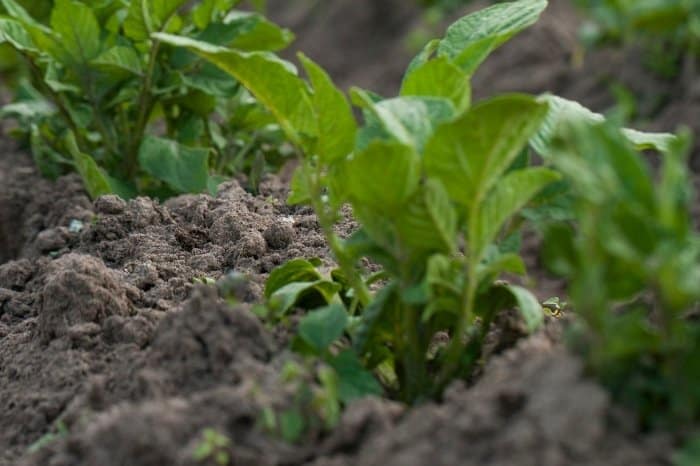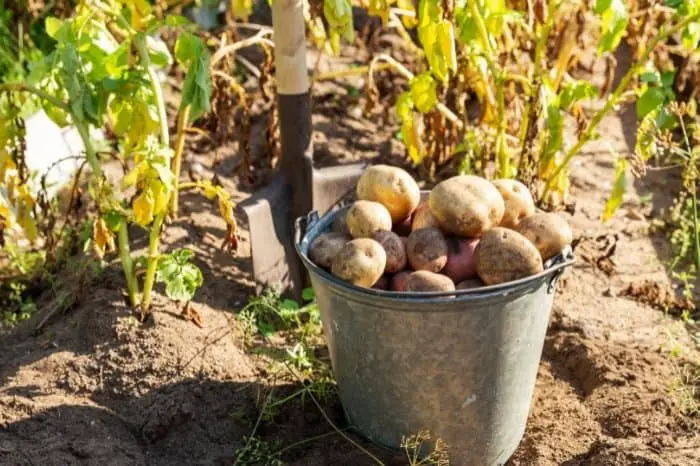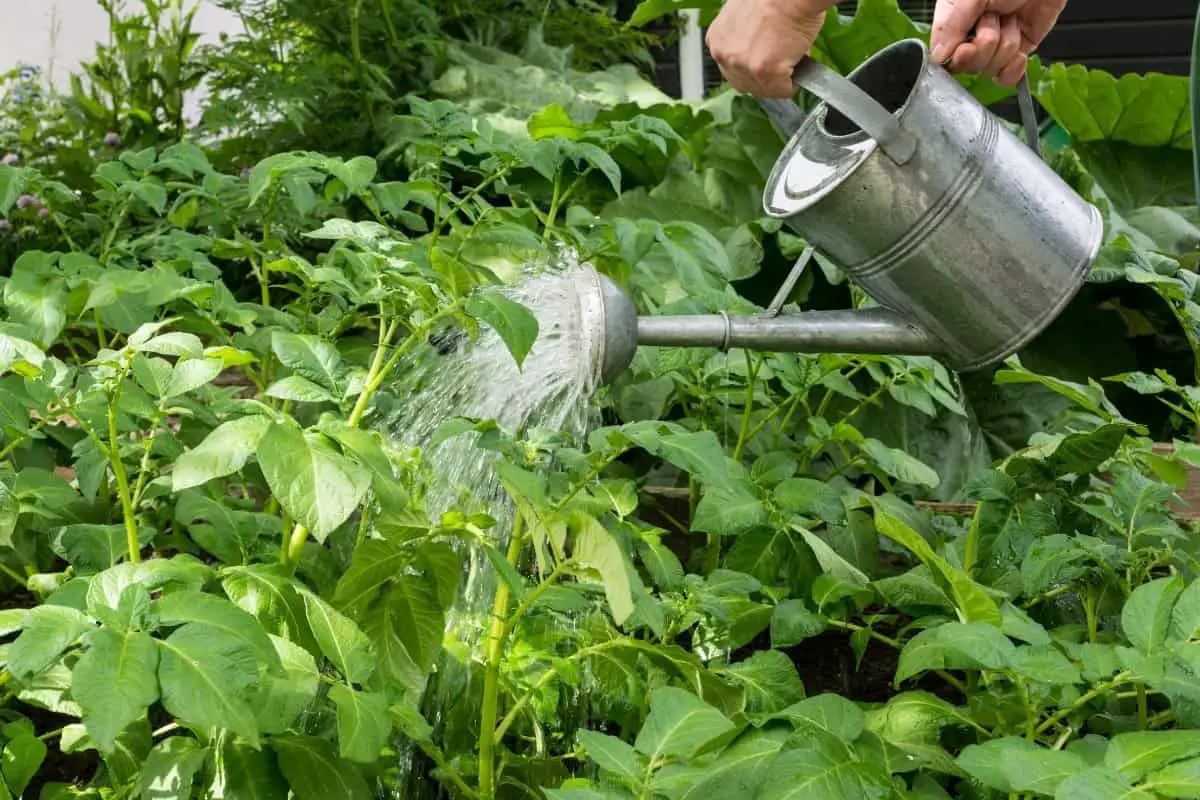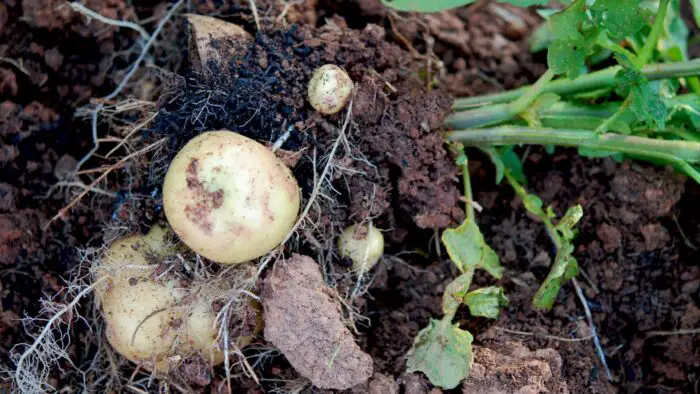Last Updated on March 2, 2023 by Griselda M.
It is important to understand how much water do potatoes need as it will prevent your crop from rotting. When growing this crop, how often to water potatoes is a topic that most gardeners struggle with, not knowing or understanding the demands of the plant.
Growing a bountiful crop of potatoes in your home garden is possible, but you need to know the basics, especially the care, maintenance, and water requirements for potatoes.
Potato plants need a consistent watering schedule and cool soil temperatures to produce a good crop. Too much or too little water can jeopardize the plant’s health and impair tuber formation, which will result in a heavily flawed harvest. As gardeners and growers, avoiding these types of issues is simple. Let’s find out how much water potatoes need below and more valuable tips for growing them.
How Often to Water Potatoes
Potatoes need different amounts of water at various times to produce to the best of their ability. Generally, potatoes require at least 1-2 inches of water each week without allowing them to dry out.
Water needs for your potatoes during their growing season are as follows:
-
-
From planting to 30 days: Low water needs.
-
30-60 days: Water is critical for vegetative growth and early tuber formation.
-
60-90 days: Water is essential for tuber bulking.
-
90-120 days: Tops begin to yellow and die back. Average water is needed but not excessively because they are nearing harvest.
-
Potato plants should be watered deeply, especially if the weather is scorching and dry. The soil should always maintain a moisture level of 8 to 10 inches underground. You should also ensure that you do not overwater the potatoes 2 weeks after planting. During the first weeks of planting, water after every 4 to 5 days.
6 to 8 weeks after planting, water the plants every single day or 2 days apart. During this time, the plant begins to make new potatoes underground. Watering them frequently will help the potatoes grow bigger and more evenly.
So to answer the question of how often should I water potatoes, it is best to give them plenty of water. However, too much could cause problems that could result in you losing some of your crops.
So how much water is too much? And how often is watering needed? It may not sound very easy, but we will break this down into three simple steps. All you have to do is identify each stage of the potato’s growth and follow the watering schedule we will share. Then watch your potatoes thrive!
The Three Most Important Stages to Water Potatoes
The three most critical watering stages include – flowering, tuber set, and maturing stage.
- The Flowering Stage. This is the stage where your potatoes begin to form tubers. At this stage, water your potatoes heavily, ensuring they receive enough moisture to help with production. When the flowers are in full bloom, the tubers begin to grow in size very quickly. Try watering the potato plants 4 times per week thoroughly (rather than soaking them).

-
The Tuber Stage. By watering your potatoes in the flowering stage in this manner, you will keep your plants healthy, encouraging excellent tuber production. Watering 4 times a week ensures you won’t leave your plants with wet feet. Also keep in mind that if the water sits for too long, it may lead to fungal infections or tuber rot.
-
Maturing Stage. Watering needs to be kept consistent until the potato plants begin to turn yellow and wilt. When they do, it shows they no longer need moisture.
Potato Plant Watering Method
Drip irrigation is the best method of potato watering. This is because overhead irrigation can hurt young, fragile plants.
Using a watering can tends to direct too much water to the foliage and very little to its roots, where it’s needed most. Wet foliage encourages fungal growth weakening the plant structure. When it comes to potato plant care, wet foliage is not what you need if you’re aiming for an abundant vegetable harvest.
Considerations to Take When You Water Potatoes
-
Do Not Overwater. Over-watering potato plants promote root rot, cause irregular tuber formation, and increase the risk of disease.
-
Do Not Underwater. Underwatering makes the soil dry out completely, prohibiting tuber formation and leading to irregular tubers with imperfections. Poor watering practices result in stressed plants that may not be overcome or take long, even if the issue is corrected.
Blumat Classic Plant Watering Stakes | for Everyday Home or Vacation Use
It is best to water your potatoes in the early morning hours to avoid the afternoon sun evaporating all the moisture. The afternoon sun is usually hot and causes the water to dry out first before the plant has a chance to take it in.
You can also put a layer of mulch around potato plants, especially after they blossom. Straw, grass clippings, chopped-up leaves, and shredded newspapers all work well as mulch. Mulching will allow the soil to retain moisture and help prevent the growth of weeds.
The Potatoes Maturity Stage
As the plants wither, changing their color to yellow, it’s time to stop watering. This stage allows the potatoes to cure and harden, so they are ready for harvesting. The curing stage for potatoes lasts between 1 and 2 weeks.
Cover the bed with a breathable, waterproof tarp that will allow some light in during the final week of curing. This is the best to use in areas with heavy clay soil that may never dry out.
The curing process toughens the potato’s skin, giving them the ability to store very well for extended periods. Excess water slows this process down or causes root rot in extremely wet conditions.
Remember, as potatoes get closer to their harvesting time, they need less water. This helps them cure, dry, and toughen up before you harvest them, thus lasting longer in storage.

Harvesting Your Potatoes
When you stop watering to allow the potato plants to cure, remember that you don’t need water anywhere near these mature potatoes, even if the soil looks dry. Any contact with water can make your potatoes rot, which is the last thing any gardener wants, especially after all the hard work.
Once you harvest your crop, let it dry for 2 to 3 days to remove all the soil and then store them. Ensure that you keep them in a cool, dry place, away from any moisture or direct sunlight.
How Much Water Does a Potato Plant Need per Day?
So, how much water does a potato plant need per day? This question is often asked by growers, as knowing the correct amount will result in abundant and healthy potato harvests. Therefore, it is of vital importance to know how much water potatoes need every day. A total of one to two inches of water provided to your plant weekly would be ideal. In other words, this amount should be divided into daily watering for the best results.
Keep in mind that overwatering your potatoes early in the season will flaw the tubers and produce lenticel growth and powdery scabs. You should also monitor weather conditions when growing potatoes outdoors because water is also provided by rain, aside from manual watering. The exact amount of moisture is important, as too much or too little can have damaging results.
Additionally, well-drained loose loam soil is best for potatoes. Unlike heavy clay-based soils that retain water, loam has exceptional drainage properties, which are important for potato plants. You should also remember that watering your plants two to three weeks before harvest time is not recommended. This is because potatoes that are harvested from dry soil last much longer in storage than those that are picked when the soil is wet.
Do You Water Potatoes Right After Planting?
A lot of people have asked, do you water potatoes, right after planting? The answer to this question is no. Potato plants should not be watered directly after they are planted. This is because newly planted potatoes become prone to disease if fed moisture. Therefore, it is best to wait until the potato sprouts are visible before feeding them any moisture. Mishappen potatoes occur from excessive watering after planting or too less moisture as they develop.
So, to harvest a healthy crop, following the correct watering schedules from the time your plant your seed potatoes is essential. It is also vital to understand how much water potatoes need to grow their best. Evenly moist potato plots that have evident signs of growth will result in delicious harvests. For this reason, weekly waterings of one to two inches are recommended.
Growing Potatoes in Water – Tips
If you want tips for growing potatoes in water, then we have some great information for you. Potatoes are usually grown from an eye in the water. Seeing that water-grown potatoes need space to grow, you should also consider the type of jar you are going to plant them in. Listed below are a few essential tips for growing your potato plants in water and more.
Tips for growing potatoes in water:
- Ensure that your potato plant leaves don’t grow out of control when planted in the water.
- Potato blight is often caused by constantly wet leaves when they are grown in water jars. This is a disease that will result in flawed growth and rotten potatoes.
- You also need to keep in mind that after a while in the water, transplanting the plant to the soil will allow for a larger potato harvest. However, this is not necessary as you can harvest them straight from the jar if you prefer a smaller-sized potato.
- In some instances, using multiple containers may be necessary for starting your potato plants in water. However, this will depend on the number of plants you want to grow.
- It is also essential to know how much water potatoes need when they are growing in glass jars.
- One or two inches of water is recommended to start your potato eye in a jar.
- For the potato to sprout in water, it is advisable to place it in a sunny spot for the best results.
- After sprouting, you can add more water to the container. However, ensure that only half the potato is submerged in water.
- At this stage, water levels should be monitored, and more should be added if needed.
Potato Irrigation Scheduling
Potato irrigation scheduling has several methods that can be implemented. These methods are important to consider where scheduling is concerned. Irrigation methods that work best for potatoes include sprinkler irrigation that involves rows on hilltops. Additionally, furrow irrigation and drip irrigation systems are also quite common as they are used by growers far and wide. There are several advantages and disadvantages to using these systems, but ultimately, choosing the one that suits your planting needs best would be beneficial.
Take heed of the tips and irrigation schedules for potato plants below to learn more:
- Water stress is not easily tolerated by potatoes when they are growing.
- Keeping the soil water potential at optimal levels using precise irrigation schedules will result in significantly favorable results when growing potatoes.
- Keep in mind that losses in market grade, yield, and tuber quality are all caused by under-irrigation, while disease susceptibility, erosion, tuber loss, and water loss is due to overly-irrigated crop.
- The checkbook method, which includes crop evapotranspiration, is a successful irrigation scheduling method that has proven effective for potato plants.
- Using a graph for soil moisture is also an effective irrigation method for potatoes as it identifies the water retention and content of the growing medium.
- Additionally, you can also opt to make use of a combination of both the above-mentioned irrigation scheduling methods if it works for you.
Conclusion
Having learned how often to water potatoes, it is now easier to grow them in your home garden or containers. Knowing the basic water requirements for potatoes and following them during the growing period is vital to producing a good crop.
Next time you are growing potatoes, be sure to follow the watering steps we have shared above to help you develop a healthy-looking and delicious crop. Then you will discover the joy of harvesting your potatoes and enjoying them as much as you wish.
FAQs
How do you grow Kennebec potatoes?
Kennebec potatoes are a type of potato that is most likely to be grown in the US states of Maine and New Hampshire. They are often also called "New England Potatoes".
Kennebec potatoes are rooted tubers which have been long-cultivated in America since the early 1800s. The term "Kennebec" comes from the Native American word for "river". The Kennebec River flows through Maine and New Hampshire, irrigating crops and providing a reliable water supply.
They grow well in cool, wet climates because they have a thick skin and a low water requirement.
Grow the spuds in deep, fertile soil with rich organic matter such as leaf compost and well-rotted manure. Add anything you like to this soil: compost, manure, kitchen and garden waste, sand or gravel.
The ground should be about 8 inches deep before planting (or about 12 inches for shallow rooted plants). The soil should be kept moist during the growing season but never wet. Provide overhead trellis for vines to climb on or use a fencing system with wire netting on all sides.
Plant in early spring.
How long does it take for Kennebec potatoes to produce?
Kennebec potatoes unfortunately take a long time to produce. They are planted in May and harvested in October.
Kennebec potatoes are grown on farms in Kennebec County, Maine. They take about six months to grow from planting to harvest.
Kennebec potato production is highly seasonal with peak production in the summer months. This is because there's less rainfall during the summer months and the soil is warmer.
Do Kennebec potatoes store well?
Kennebec potatoes are small potato tubers that are often used in making French fries. They usually keep well for about a week if stored properly.
Kennebec potatoes store well in the crisper drawer of your refrigerator for about a week.
What do Kennebec potatoes look like?
Kennebec potatoes, also known as New England-style potatoes, are small and round with a light tan skin and an ivory-white flesh. These potatoes are best eaten raw or boiled. The Kennebec potato was originally bred in the mountain valleys of Maine by early settlers who wanted to grow something that would thrive in highly acidic soils and harsh weather conditions.
Are Kennebec potatoes waxy or starchy?
Kennebec Potatoes are a type of potato that is waxy in nature. Kennebec potatoes were originally developed in Maine and were found to be delicious.
Starchy potatoes, on the other hand, are less wet than waxy potatoes and starchy potatoes can feel dense to eat when boiled or baked.
Should you wash potatoes before storing?
It is important to understand that potatoes should not be washed before they are stored because this will remove some of the natural oils and enzymes. Washing the potatoes before storing could make them more susceptible to disease.
Caroline is a gardener who loves to get down to the nitty–gritty of gardening. She proudly proclaims herself as a ‘dirt worshipper‘ and can often be found deep in the garden, covered in soil and singing to her plants. As a self–proclaimed ‘plant whisperer‘, Caroline believes that plants need love and attention just like any other living thing, and she loves to give them both. When she‘s not tending to her garden, you can often find her researching the latest gardening trends, or teaching others how to make their gardens thrive




